Abstract
Perinatal exposure to carcinogens may contribute to the determination of susceptibility to cancer in two situations: a) exposure in utero of embryonal or fetal somatic cells to carcinogens, and b) prezygotic exposure of the germ cells of one or both parents to carcinogens. Epidemiological as well as experimental studies demonstrate that exposure to carcinogens in utero increases the occurrence of cancer postnatally. Studies with experimental animals suggest that prezygotic exposure of germ cells to carcinogens can result in an increased incidence of cancer not only in immediate but also in subsequent generations. Although several studies suggest a transgeneration effect of carcinogens in human populations, the evidence cannot yet be considered conclusive. In particular, while some hypotheses can be advanced, the mechanism(s) by which increased susceptibility or predisposition to cancer may be transmitted via the germ cells has not yet been clarified. In conjunction with exposure both in utero and prezygotically, it is important to consider postnatal exposure to possible tumor-promoting agents. Results from experimental animals suggest that oncogenes can be activated transplacentally, and human studies indicate that tumor-suppressor gene inactivation may be involved in the transgenerational effect of carcinogens.
Full text
PDF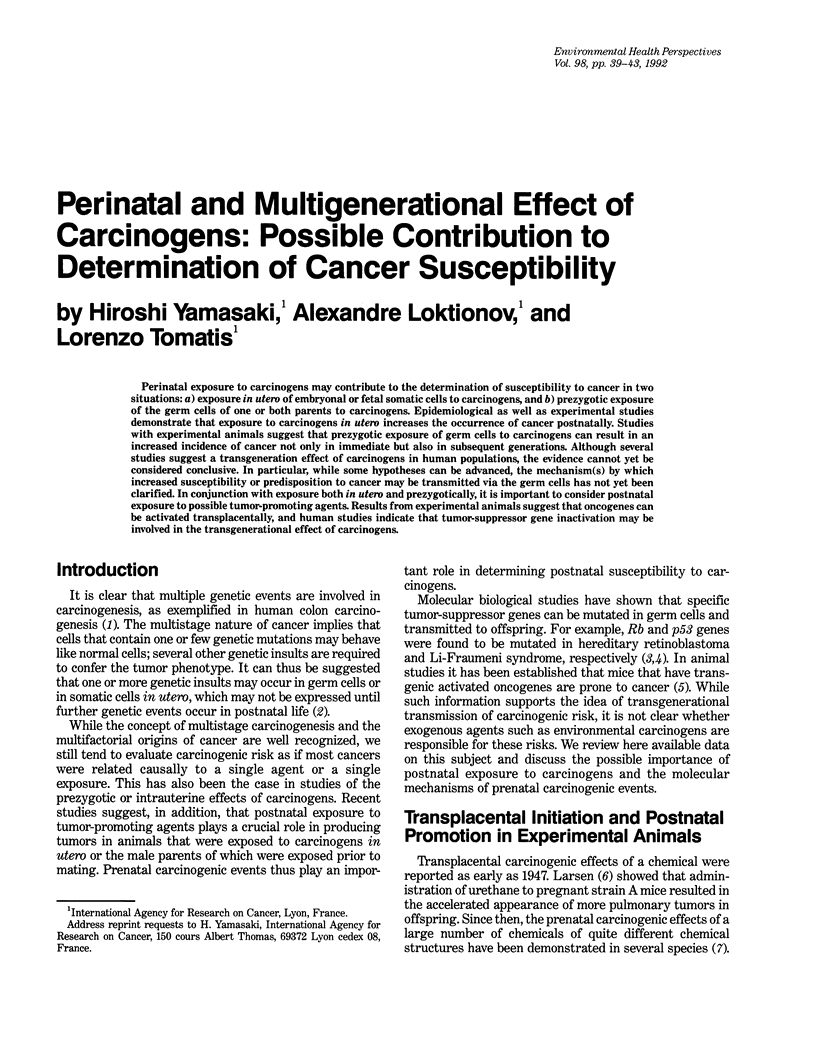
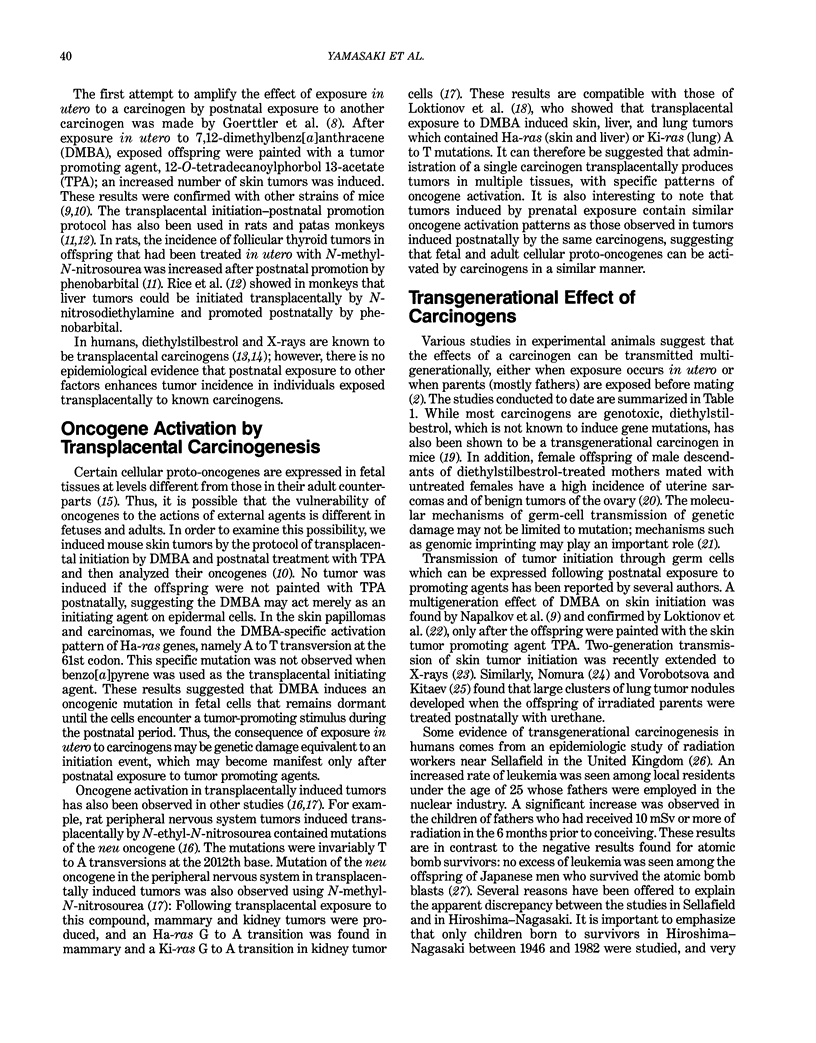
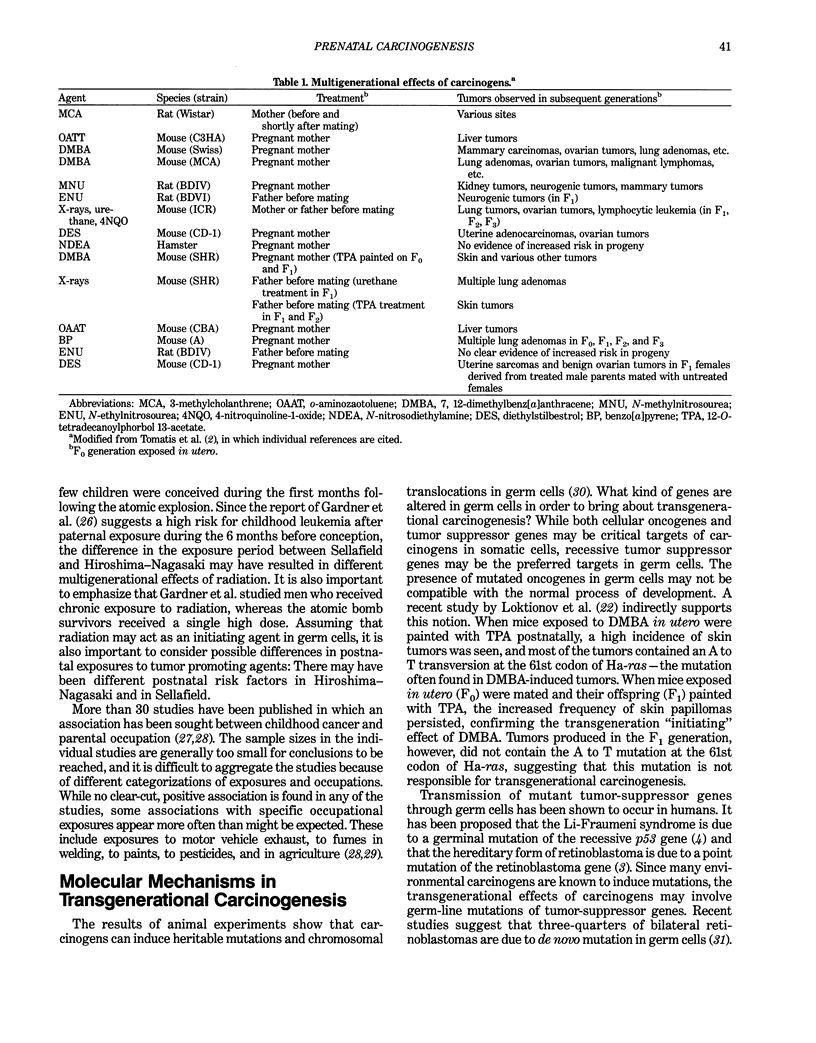
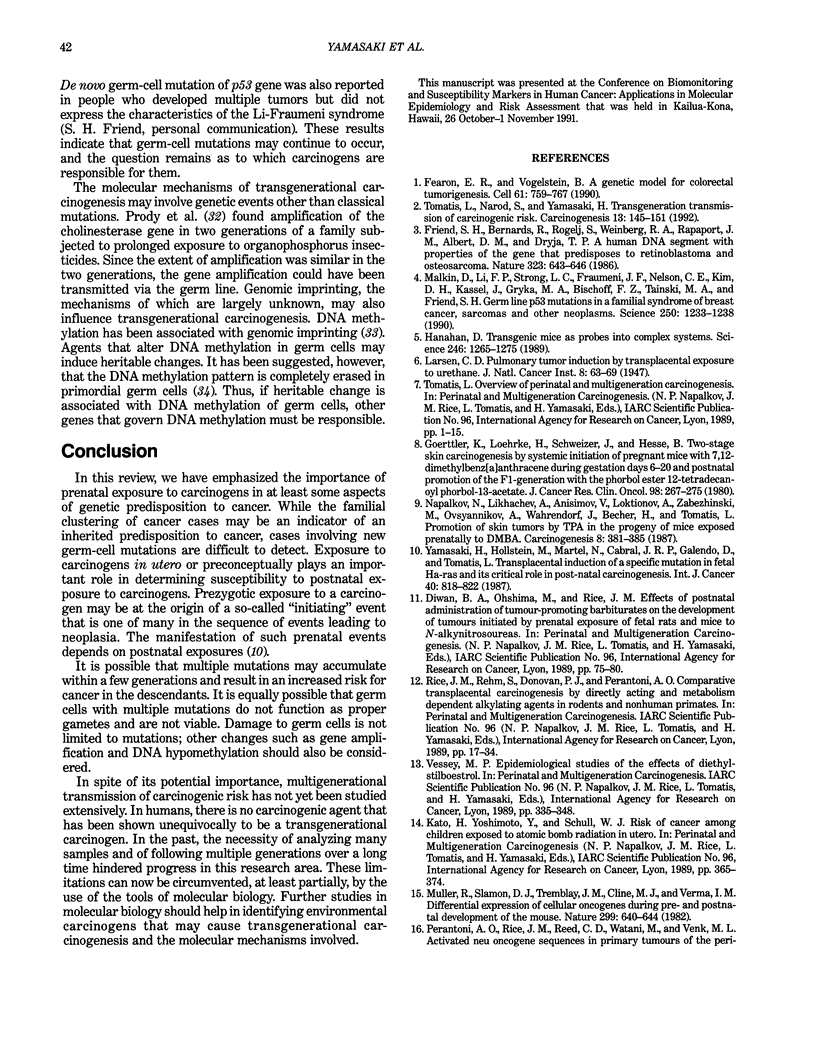
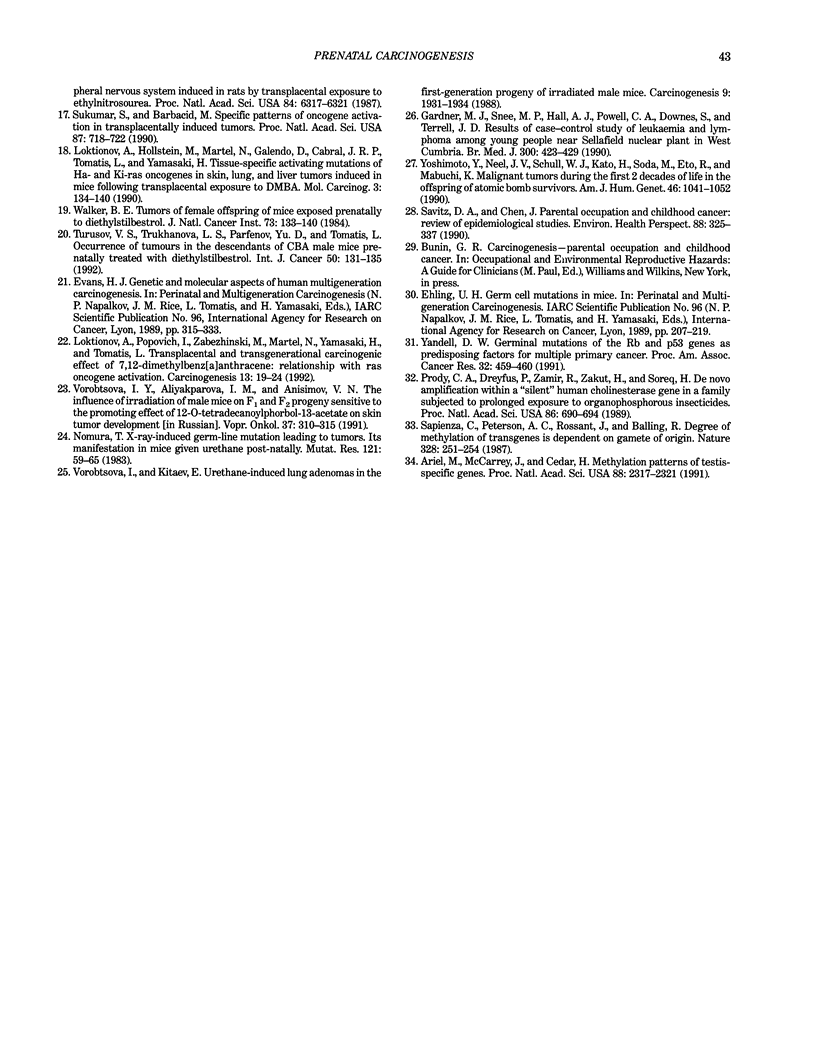
Selected References
These references are in PubMed. This may not be the complete list of references from this article.
- Ariel M., McCarrey J., Cedar H. Methylation patterns of testis-specific genes. Proc Natl Acad Sci U S A. 1991 Mar 15;88(6):2317–2321. doi: 10.1073/pnas.88.6.2317. [DOI] [PMC free article] [PubMed] [Google Scholar]
- Fearon E. R., Vogelstein B. A genetic model for colorectal tumorigenesis. Cell. 1990 Jun 1;61(5):759–767. doi: 10.1016/0092-8674(90)90186-i. [DOI] [PubMed] [Google Scholar]
- Friend S. H., Bernards R., Rogelj S., Weinberg R. A., Rapaport J. M., Albert D. M., Dryja T. P. A human DNA segment with properties of the gene that predisposes to retinoblastoma and osteosarcoma. Nature. 1986 Oct 16;323(6089):643–646. doi: 10.1038/323643a0. [DOI] [PubMed] [Google Scholar]
- Gardner M. J., Snee M. P., Hall A. J., Powell C. A., Downes S., Terrell J. D. Results of case-control study of leukaemia and lymphoma among young people near Sellafield nuclear plant in West Cumbria. BMJ. 1990 Feb 17;300(6722):423–429. doi: 10.1136/bmj.300.6722.423. [DOI] [PMC free article] [PubMed] [Google Scholar]
- Goerttler K., Loehrke H., Schweizer J., Hesse B. Two-stage skin carcinogenesis by systemic initiation of pregnant mice with 7,12-dimethylbenz(a)anthracene during gestation days 6-20 and postnatal promotion of the F 1-generation with the phorbol ester 12-tetradecanoylphorbol-13-acetate. J Cancer Res Clin Oncol. 1980;98(3):267–275. doi: 10.1007/BF00410789. [DOI] [PubMed] [Google Scholar]
- Hanahan D. Transgenic mice as probes into complex systems. Science. 1989 Dec 8;246(4935):1265–1275. doi: 10.1126/science.2686032. [DOI] [PubMed] [Google Scholar]
- Loktionov A., Hollstein M., Martel N., Galendo D., Cabral J. R., Tomatis L., Yamasaki H. Tissue-specific activating mutations of Ha- and Ki-ras oncogenes in skin, lung, and liver tumors induced in mice following transplacental exposure to DMBA. Mol Carcinog. 1990;3(3):134–140. doi: 10.1002/mc.2940030306. [DOI] [PubMed] [Google Scholar]
- Loktionov A., Popovich I., Zabezhinski M., Martel N., Yamasaki H., Tomatis L. Transplacental and transgeneration carcinogenic effect of 7,12-dimethylbenz[a]anthracene: relationship with ras oncogene activation. Carcinogenesis. 1992 Jan;13(1):19–24. doi: 10.1093/carcin/13.1.19. [DOI] [PubMed] [Google Scholar]
- Malkin D., Li F. P., Strong L. C., Fraumeni J. F., Jr, Nelson C. E., Kim D. H., Kassel J., Gryka M. A., Bischoff F. Z., Tainsky M. A. Germ line p53 mutations in a familial syndrome of breast cancer, sarcomas, and other neoplasms. Science. 1990 Nov 30;250(4985):1233–1238. doi: 10.1126/science.1978757. [DOI] [PubMed] [Google Scholar]
- Müller R., Slamon D. J., Tremblay J. M., Cline M. J., Verma I. M. Differential expression of cellular oncogenes during pre- and postnatal development of the mouse. Nature. 1982 Oct 14;299(5884):640–644. doi: 10.1038/299640a0. [DOI] [PubMed] [Google Scholar]
- Napalkov N., Likhachev A., Anisimov V., Loktionov A., Zabezhinski M., Ovsyannikov A., Wahrendorf J., Becher H., Tomatis L. Promotion of skin tumours by TPA in the progeny of mice exposed pre-natally to DMBA. Carcinogenesis. 1987 Mar;8(3):381–385. doi: 10.1093/carcin/8.3.381. [DOI] [PubMed] [Google Scholar]
- Nomura T. X-ray-induced germ-line mutation leading to tumors. Its manifestation in mice given urethane post-natally. Mutat Res. 1983 Jul;121(1):59–65. doi: 10.1016/0165-7992(83)90087-8. [DOI] [PubMed] [Google Scholar]
- Perantoni A. O., Rice J. M., Reed C. D., Watatani M., Wenk M. L. Activated neu oncogene sequences in primary tumors of the peripheral nervous system induced in rats by transplacental exposure to ethylnitrosourea. Proc Natl Acad Sci U S A. 1987 Sep;84(17):6317–6321. doi: 10.1073/pnas.84.17.6317. [DOI] [PMC free article] [PubMed] [Google Scholar]
- Prody C. A., Dreyfus P., Zamir R., Zakut H., Soreq H. De novo amplification within a "silent" human cholinesterase gene in a family subjected to prolonged exposure to organophosphorous insecticides. Proc Natl Acad Sci U S A. 1989 Jan;86(2):690–694. doi: 10.1073/pnas.86.2.690. [DOI] [PMC free article] [PubMed] [Google Scholar]
- Sapienza C., Peterson A. C., Rossant J., Balling R. Degree of methylation of transgenes is dependent on gamete of origin. Nature. 1987 Jul 16;328(6127):251–254. doi: 10.1038/328251a0. [DOI] [PubMed] [Google Scholar]
- Savitz D. A., Chen J. H. Parental occupation and childhood cancer: review of epidemiologic studies. Environ Health Perspect. 1990 Aug;88:325–337. doi: 10.1289/ehp.9088325. [DOI] [PMC free article] [PubMed] [Google Scholar]
- Sukumar S., Barbacid M. Specific patterns of oncogene activation in transplacentally induced tumors. Proc Natl Acad Sci U S A. 1990 Jan;87(2):718–722. doi: 10.1073/pnas.87.2.718. [DOI] [PMC free article] [PubMed] [Google Scholar]
- Tomatis L., Narod S., Yamasaki H. Transgeneration transmission of carcinogenic risk. Carcinogenesis. 1992 Feb;13(2):145–151. doi: 10.1093/carcin/13.2.145. [DOI] [PubMed] [Google Scholar]
- Tomatis L. Overview of perinatal and multigeneration carcinogenesis. IARC Sci Publ. 1989;(96):1–15. [PubMed] [Google Scholar]
- Turusov V. S., Trukhanova L. S., Parfenov YuD, Tomatis L. Occurrence of tumours in the descendants of CBA male mice prenatally treated with diethylstilbestrol. Int J Cancer. 1992 Jan 2;50(1):131–135. doi: 10.1002/ijc.2910500126. [DOI] [PubMed] [Google Scholar]
- Vorobtsova I. E., Aliiakparova L. M., Anisimov V. N. Vliianie oblucheniia samtsov myshei na chuvstvitel'nost' dvukh pokolenii potomstva k deistviiu promotora opukholei kozhi 12-0-tetradekanoilforbol-13-atsetata. Vopr Onkol. 1991;37(3):310–315. [PubMed] [Google Scholar]
- Vorobtsova I. E., Kitaev E. M. Urethane-induced lung adenomas in the first-generation progeny of irradiated male mice. Carcinogenesis. 1988 Nov;9(11):1931–1934. doi: 10.1093/carcin/9.11.1931. [DOI] [PubMed] [Google Scholar]
- Walker B. E. Tumors of female offspring of mice exposed prenatally to diethylstilbestrol. J Natl Cancer Inst. 1984 Jul;73(1):133–140. [PubMed] [Google Scholar]
- Yamasaki H., Hollstein M., Martel N., Cabral J. R., Galendo D., Tomatis L. Transplacental induction of a specific mutation in fetal Ha-ras and its critical role in post-natal carcinogenesis. Int J Cancer. 1987 Dec 15;40(6):818–822. doi: 10.1002/ijc.2910400619. [DOI] [PubMed] [Google Scholar]
- Yoshimoto Y., Neel J. V., Schull W. J., Kato H., Soda M., Eto R., Mabuchi K. Malignant tumors during the first 2 decades of life in the offspring of atomic bomb survivors. Am J Hum Genet. 1990 Jun;46(6):1041–1052. [PMC free article] [PubMed] [Google Scholar]


